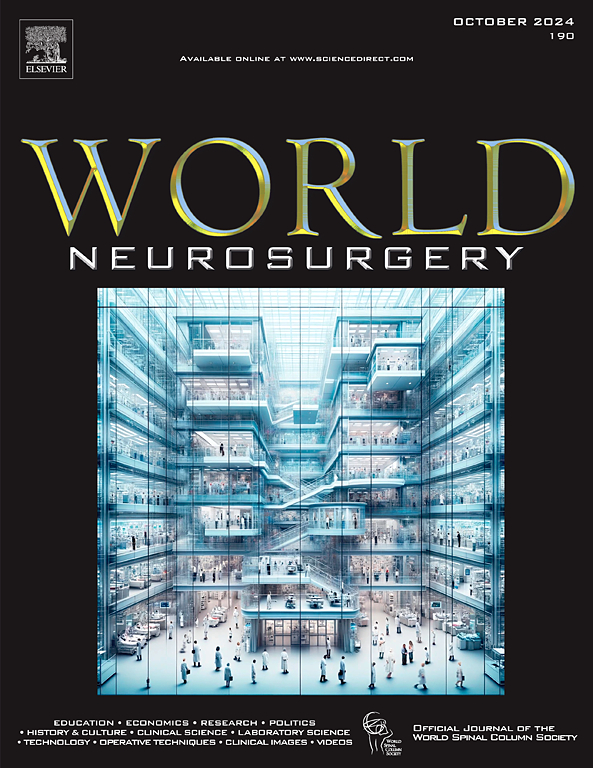依那普利与心得安对孤立性重型颅脑损伤神经功能恢复的疗效及安全性的随机临床研究。
IF 1.9
4区 医学
Q3 CLINICAL NEUROLOGY
引用次数: 0
摘要
目的:推测普萘洛尔和依那普利对重型颅脑损伤(TBI)患者的神经功能恢复均无不良影响,但均具有心血管稳定性。普萘洛尔和依那普利被认为是创伤性脑损伤中有益的心血管稳定剂。然而,它们对神经系统的影响仍有许多不清楚之处。方法:本研究采用单盲随机临床试验,于2020 - 2021年在2所大学医院进行。所有年龄在18岁以上的严重孤立性脑损伤患者均经监护人合法同意参与研究。G1组(心得安),G2组(依那普利),G3组(心得安+依那普利),G4组(未用药)。格拉斯哥结局量表扩展(GOS-E)被定义为主要结局。次要结局包括言语失用评定量表(ASRS)、心血管稳定性、死亡率、呼吸机依赖和住院时间。P≤0.05为显著性。结果:140例患者纳入最终分析。平均年龄36.91±16.19岁,中位GCS为5。4组患者基线生命体征及TBI严重程度指数分布均匀(P < 0.05)。多因素回归分析显示,各组GOS-E与出院GCS直接相关(p结论:在神经功能恢复及其他预后方面,依那普利、心得安单用或联用对重度孤立性TBI患者均有效且安全。考虑到长期结果,在随访期间,心得安在GOS-E中显示出更有希望的结果。本文章由计算机程序翻译,如有差异,请以英文原文为准。
Efficacy and Safety of Enalapril and Propranolol on Neurologic Recovery After Isolated Severe Traumatic Brain Injury: A Randomized Clinical Trial
Objective
It has been hypothesized that propranolol and enalapril can provide cardiovascular stability without any negative impact on neurologic recovery after severe traumatic brain injury (TBI). Although propranolol and enalapril have been proposed to have beneficial effects as cardiovascular stabilizers in TBI, many neurologic effects remain obscure. We hypothesized which of the following drugs could improve The Glasgow Outcome Scale-extended (GOS-E) in severe TBI patients.
Methods
This single-blinded randomized, clinical trial was conducted in 2 university hospitals from 2020 to 2021. All the patients age >18 years with severe isolated TBI who had legal consent to participate (by guardians) were enrolled. G1 (propranolol), G2 (enalapril), G3 (propranolol + enalapril), and G4 (no medication) were defined. The GOS-E was the primary outcome. Secondary outcomes included the Apraxia of Speech Rating Scale, cardiovascular stability, mortality rate, ventilator dependency, and hospital length of stay. P ≤ 0.05 was defined as significant.
Results
One hundred and forty patients were reviewed in the final analysis. The mean patient age was 36.91 ± 16.19 years, and the median Glasgow Coma Scale (GCS) score was 5. Baseline vital signs and TBI severity indices were distributed equally among the 4 groups (P > 0.05). Multivariate regression analysis showed that GOS-E was directly associated with discharge GCS in all groups (P < 0.001, β = 0.199, 0.16 ≤ confidence interval [CI] ≤ 0.22). Multivariate regression analysis showed better on-discharge GCS in G1 (P < 0.001; β = 2.26; 0.58 ≤ CI ≤ 3.9).
Conclusion
Regarding neurologic recovery and other outcomes, enalapril and propranolol, both alone and in combination, are effective and safe after severe isolated TBI. Considering long-term outcomes, propranolol showed more promising results in GOS-E during the follow-up period.
求助全文
通过发布文献求助,成功后即可免费获取论文全文。
去求助
来源期刊

World neurosurgery
CLINICAL NEUROLOGY-SURGERY
CiteScore
3.90
自引率
15.00%
发文量
1765
审稿时长
47 days
期刊介绍:
World Neurosurgery has an open access mirror journal World Neurosurgery: X, sharing the same aims and scope, editorial team, submission system and rigorous peer review.
The journal''s mission is to:
-To provide a first-class international forum and a 2-way conduit for dialogue that is relevant to neurosurgeons and providers who care for neurosurgery patients. The categories of the exchanged information include clinical and basic science, as well as global information that provide social, political, educational, economic, cultural or societal insights and knowledge that are of significance and relevance to worldwide neurosurgery patient care.
-To act as a primary intellectual catalyst for the stimulation of creativity, the creation of new knowledge, and the enhancement of quality neurosurgical care worldwide.
-To provide a forum for communication that enriches the lives of all neurosurgeons and their colleagues; and, in so doing, enriches the lives of their patients.
Topics to be addressed in World Neurosurgery include: EDUCATION, ECONOMICS, RESEARCH, POLITICS, HISTORY, CULTURE, CLINICAL SCIENCE, LABORATORY SCIENCE, TECHNOLOGY, OPERATIVE TECHNIQUES, CLINICAL IMAGES, VIDEOS
 求助内容:
求助内容: 应助结果提醒方式:
应助结果提醒方式:


